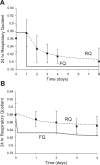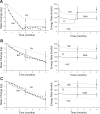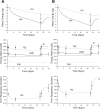Predicting metabolic adaptation, body weight change, and energy intake in humans
- PMID: 19934407
- PMCID: PMC2838532
- DOI: 10.1152/ajpendo.00559.2009
Predicting metabolic adaptation, body weight change, and energy intake in humans
Abstract
Complex interactions between carbohydrate, fat, and protein metabolism underlie the body's remarkable ability to adapt to a variety of diets. But any imbalances between the intake and utilization rates of these macronutrients will result in changes in body weight and composition. Here, I present the first computational model that simulates how diet perturbations result in adaptations of fuel selection and energy expenditure that predict body weight and composition changes in both obese and nonobese men and women. No model parameters were adjusted to fit these data other than the initial conditions for each subject group (e.g., initial body weight and body fat mass). The model provides the first realistic simulations of how diet perturbations result in adaptations of whole body energy expenditure, fuel selection, and various metabolic fluxes that ultimately give rise to body weight change. The validated model was used to estimate free-living energy intake during a long-term weight loss intervention, a variable that has never previously been measured accurately.
Figures






References
-
- Aarsland A, Chinkes D, Wolfe RR. Hepatic and whole-body fat synthesis in humans during carbohydrate overfeeding. Am J Clin Nutr 65: 1774–1782, 1997. - PubMed
-
- Acheson KJ, Schutz Y, Bessard T, Anantharaman K, Flatt JP, Jequier E. Glycogen storage capacity and de novo lipogenesis during massive carbohydrate overfeeding in man. Am J Clin Nutr 48: 240–247, 1988. - PubMed
-
- Alpert SS. Growth, thermogenesis, and hyperphagia. Am J Clin Nutr 52: 784–792, 1990. - PubMed
-
- Alpert SS. A limit on the energy transfer rate from the human fat store in hypophagia. J Theor Biol 233: 1–13, 2005. - PubMed
-
- Alpert SS. A two-reservoir energy model of the human body. Am J Clin Nutr 32: 1710–1718, 1979. - PubMed
Publication types
MeSH terms
Grants and funding
LinkOut - more resources
Full Text Sources
Other Literature Sources
Medical

